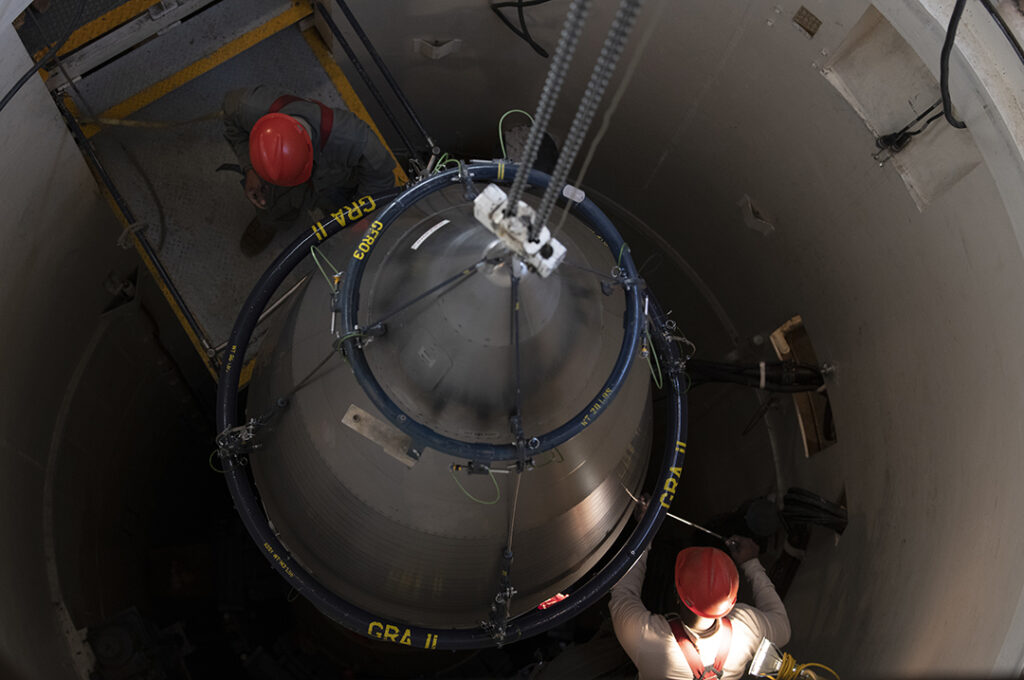THE WATCH STAFF
When the Air Force deployed its first Minuteman III intercontinental ballistic missile (ICBM), the United States was fighting the Vietnam War and an Army nurse had recently become the military’s first female general.
More than 50 years later, 400 Minuteman IIIs still stand guard in their silos.
“Minuteman III was a 10-year weapon system that was asked to last 60 years,” Maj. Gen. Anthony W. Genatempo, commander of the U.S. Air Force Nuclear Weapons Center (AFNWC), said of the 1970 introduction of the ballistic missile.
Genatempo spoke about the Minuteman III’s proposed replacement — the Ground-Based Strategic Deterrent (GBSD) missile — during a June 2021 conference of the Air Force Association (AFA), according to a September 7 story in Air Force Magazine.
Genatempo, who also is the Air Force’s program executive officer for strategic systems, said the aging Minuteman III’s last update in 2010 required significant reverse engineering. The updates included replacement boosters and missile guidance computers, according to a November 10, 2020, report by the Congressional Research Service (CRS).
(Pictured: Airmen from the 90th Maintenance Group perform maintenance on a Minuteman III in 2019 at the F.E. Warren Air Force Base missile complex in Wyoming.)
In the next decade, those components may face reliability issues as they reach the end of their intended lifespan, known as “aging out,” according to the CRS report.
“There’s no margin left,” Gen. Timothy M. Rayhe, chief of Global Strike Command, said of retrofitting the Minuteman III, according to a June 14, 2021, story in Air Force Magazine.
The GBSD is designed to be easily and quickly updated, Genatempo said.
Lawmakers still must authorize and appropriate funding for the GBSD, which is already moving toward production. Cost estimates for the GBSD are close to U.S. $100 billion for acquisition and U.S. $264 billion over its lifetime, which is set to run into the mid-2070s. President Joe Biden’s fiscal year 2022 budget request included U.S. $2.6 billion for the project, according to National Defense magazine.
Most Americans support modernizing the U.S. nuclear triad — ICBMs, long-range bombers and ballistic missile submarines — according to a survey released September 16, 2021, and commissioned by the AFA’s Mitchell Institute for Aerospace Studies.
Northrop Grumman received a U.S. $13.3 billion contract in 2020 to develop the GBSD. In August 2021, Northrop opened a U.S. $1.4 billion facility in Colorado dedicated to the GBSD and other weapons programs, according to September 9 report in Defense News magazine.
The GBSD missile is expected to be flight-tested by the end of 2023 and achieve initial operational capability in 2029, Air Force GBSD program manager Col. Jason Bartolomei said during the AFA conference. He said the GBSD is expected to be fully operational with 400 missiles in 2036.
As the GBSD is developed and fielded, the Air Force must also update its ICBM framework.
That will include “missile launch facilities and support infrastructure, launch control centers, squadron and wing support infrastructure, and command and control systems, as well as policies, processes, procedures, security, the supply chain, and even the workforce,” Air Force Magazine said in the September 7 report.
“The Air Force operational tempo is to effectively replace one missile per week for nine years without sacrificing sortie alert status,” Ryan McKeon, director of strategy and defense at global management consultant Guidehouse, told Air Force Magazine. “That’s an incredibly complex endeavor, arguably one of the most … important weapon system rollouts and deployments ever planned.”
To manage the undertaking, the AFNWC split the ICBM Systems Directorate in 2020. Two directorates now manage ICBMs at Hill Air Force Base in Utah — one for Minuteman III and the other for the GBSD.
The director of the Minuteman III systems directorate, Col. Erik Quigley, told Air Force Magazine in the June 14 story that the challenge of bringing on the GBSD while keeping the existing missiles operational is like “giving your dog a bath while walking him.”
IMAGE CREDIT: SENIOR AIRMAN ABBIGAYLE WILLIAMS/U.S. AIR FORCE

